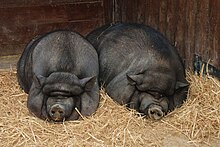ポットベリーVietnamese Pot-bellied 保全状況 FAO (2007): endangered[ 1] :130 別名 Pot-bellied Pig ベトナム語 : Lợn Ỉ Lon I I Í 原産国 ベトナム 分布 紅河デルタ [ 2] :565 用途 meat 特徴 体重 オス: average: 50 kg (110 lb)[ 3] メス: average: 48 kg (105 lb)[ 3] 体高 オス: average: 36 cm (14 in)[ 3] メス: average: 35 cm (14 in)[ 3] 毛色 black ブタ Sus scrofa domesticus
Đông Hồ painting of pigs of I typeForaging on rice terraces in Sa Pa , in Lào Cai Province ポットベリー (あるいは、ベトナムポットベリー 。英語 : Vietnamese Pot-bellied )とは、絶滅が危惧されるベトナム原産 (英語版 ) 豚 「Lon I (ベトナム語 : Lợn Ỉ I pig」[ 注釈 1] 外名 である。
ポットベリーは黒一色で、足が短い。また、お腹が低く垂れ下がっていることから、この名がついた(「Pot belly」は「太鼓腹」の意味)。
肉用として飼育され、成長は遅いが豚肉の風味は良い[ 4] :25 。
ポットベリーは、バクニン省 にある伝統的なドンホー版画 に、幸福や飽食、富の象徴として描かれている[ 2] :616 。
ポットベリーは、ベトナム固有の品種である。ベトナム (英語版 ) 紅河デルタ に位置するナムディン省 が原産地と考えられている[ 2] :616 。
紅河デルタに位置する省のほとんどで見られる地方豚品種であり、ナムディン省および隣接するハナム省 やニンビン省 、タイビン省 、さらにすぐ南のタインホア省 (北中部 地方に属する)に広く分布していた[ 2] :616 。
1970年代までは、ベトナム北部で最も頭数の多い品種であり、その数は数百万頭にも上った[ 2] :616 。しかし、その後、より生産性の高い「Móng Cái 」という品種に取って代わられるようになってしまった。この状況を危惧したベトナム国立畜産研究所は、純血種 (英語版 ) 近親交配 が増えてしまった[ 2] :616 。1991年にはポットベリーの総個体数は675,000頭と推定されていたが、2010年には推定頭数が120頭と激減した。2003年、国立畜産研究所はその保全状況 を「危機的」とし[ 5] :76 、2007年には、FAO から「絶滅の危機」と認定された[ 1] :130 。
1960年代にカナダやスウェーデンに少数のポットベリーが輸出され、動物園で飼育されたり、実験に使われたりしていた。その後、10年も経たないうちに、ヨーロッパ各国の動物園にも飼育の輪は広まり、少数ながら小規模な畜産農家 (英語版 )
1980年代半ばにカナダからアメリカに渡り、その10年後には「ポットベリーピッグ」という名称でペットとして売り出されるようになった。ただし、すべてが純血種というわけではなく、かなりの大きさに成長する個体もあったが[ 2] :616 、流行そのものは短命に終わってしまった[ 6]
一方で、2013年にはスペイン で外来種 に指定された[ 7]
ポットベリーは、平均体重が約50kgで、平均全長が約36cmの小型豚である。
全身は黒一色で、皮膚には大きく皺が寄っている。背中は大きく反り (英語版 ) 鼻 は上を向き、小さな耳や目と重くたるんだ顎を持つ[ 2] :616 。
ポットベリーは丈夫で、病気や寄生虫に対する抵抗力が強い。通常、原産地の稲わらや水草を飼料として、粗放農業 的に飼育されている。両足の4本の指に体重がかかる蹠行 性の足を持つため、特に湿地帯や泥地での活動に適応している[ 2] :616 。
この品種には、主に2つのタイプが存在する[ 2] :616 :
典型的な小型短足豚で、小さな上向きの耳と短い鼻を持つ。 背が高く、長い鼻や足を持ち、大きな耳が水平に付いている。
^ a b Barbara Rischkowsky, Dafydd Pilling (editors) (2007). List of breeds documented in the Global Databank for Animal Genetic Resources , annex to The State of the World's Animal Genetic Resources for Food and Agriculture ISBN 9789251057629 . Archived 23 June 2020.
^ a b c d e f g h i j Valerie Porter, Lawrence Alderson, Stephen J.G. Hall, D. Phillip Sponenberg (2016). Mason's World Encyclopedia of Livestock Breeds and Breeding ISBN 9781780647944 .
^ a b c d e Breed data sheet: Lon I/Viet Nam . Domestic Animal Diversity Information System of the Food and Agriculture Organization of the United Nations. Accessed June 2017.
^ Le-Thi-Thanh Huyen, Regina Roessler, Ute Lemke, Anne Valle Zárate (2005). Impact of the use of exotic compared to local pig breeds on socio-economic development and biodiversity in Vietnam . Institut für Tierproduktion in den Tropen und Subtropen Universität Hohenheim. Beuren, Stuttgart: Ulrich E. Grauer. ISBN 9783861864967 .
^ [National Institute of Animal Husbandry] (2003). The Vietnam National Country report on Animal Genetic Resources The State of the World's Animal Genetic Resources for Food and Agriculture ISBN 9789251057629 . Archived 6 January 2021.
^ The Joy of Pigs/ Pigs as Pets . PBS Nature. Accessed June 2017.^ Real Decreto 630/2013, de 2 de agosto, por el que se regula el Catálogo español de especies exóticas invasoras (in Spanish). Boletín Oficial del Estado 185 , 3 August 2013.
Nguyen, Thuy Thi Dieu (2004). Genetic diversity and distances of Vietnamese and European pig breeds analysed with microsatellite loci . Aachen: Shaker Verlag. Dissertation.


